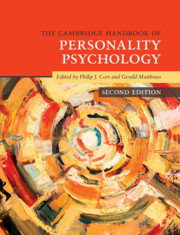Book contents
- The Cambridge Handbook of Personality Psychology
- Cambridge Handbooks in Psychology
- The Cambridge Handbook of Personality Psychology
- Copyright page
- Contents
- Figures
- Tables
- Contributors
- Preface
- General Introduction
- Part I Foundational Issues: History and Approaches to Personality
- Part II Description and Measurement: How Personality Is Studied
- Part III Development, Health and Change: Life Span and Health Outcomes
- Part IV Biological Perspectives: Evolution, Genetics and Neuroscience of Personality
- Part V Cognitive and Motivational Perspectives: Dynamic Processes of Personality
- Part VI Social and Cultural Processes: Personality at the Intersection of Society
- 27 Narrative Identity in the Social World
- 28 Social Relations and Social Support
- 29 Personality in Cross-Cultural Perspective
- 30 Personality and Politics
- Part VII Applications of Personality Psychology: Personality Traits and Processes in Action
- Addendum: Statistical Analyses and Computer Programming in Personality
- Index
- References
27 - Narrative Identity in the Social World
from Part VI - Social and Cultural Processes: Personality at the Intersection of Society
Published online by Cambridge University Press: 18 September 2020
- The Cambridge Handbook of Personality Psychology
- Cambridge Handbooks in Psychology
- The Cambridge Handbook of Personality Psychology
- Copyright page
- Contents
- Figures
- Tables
- Contributors
- Preface
- General Introduction
- Part I Foundational Issues: History and Approaches to Personality
- Part II Description and Measurement: How Personality Is Studied
- Part III Development, Health and Change: Life Span and Health Outcomes
- Part IV Biological Perspectives: Evolution, Genetics and Neuroscience of Personality
- Part V Cognitive and Motivational Perspectives: Dynamic Processes of Personality
- Part VI Social and Cultural Processes: Personality at the Intersection of Society
- 27 Narrative Identity in the Social World
- 28 Social Relations and Social Support
- 29 Personality in Cross-Cultural Perspective
- 30 Personality and Politics
- Part VII Applications of Personality Psychology: Personality Traits and Processes in Action
- Addendum: Statistical Analyses and Computer Programming in Personality
- Index
- References
Summary
Narrative as a component of personality has a long history in the field, but it is only within the last two decades that it has been fully accepted into contemporary approaches to personality (e.g., McAdams & Pals, 2006). One part of the flourishing of the field of narrative psychology has been the attention paid to the social and cultural contexts of narrative production. Yet this work has been somewhat outside the reach of personality psychology, occurring more often within the fields of developmental, cognitive and social psychology (e.g., Fivush, Haden & Reese, 2006). One of the reasons for this separation is the attention to how social and cultural contexts change narration, and a focus on malleability in psychological phenomena has not traditionally been under the purview of personality psychology. We aim to merge these areas of study – personality and social and cultural contexts of narration – by focusing on the role that those contexts play in the stability of narrative as a component of personality.
- Type
- Chapter
- Information
- The Cambridge Handbook of Personality Psychology , pp. 377 - 385Publisher: Cambridge University PressPrint publication year: 2020

